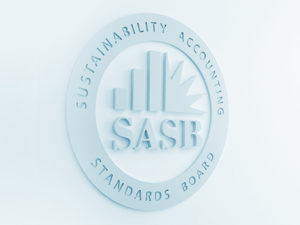
Heidi Soumerai, CFA, Managing Director, Walden Asset Management
Walden Asset Management celebrates reports from the likes of KPMG that in 2017 found approximately 75 percent of 4,900 global companies published sustainability reports. With our four-decade lens incorporating ESG considerations into our investment process, one might assume that we are satisfied with the current state of sustainability disclosure. We are not. Our need for more relevant, reliable, and comparable information on company ESG policies, practices, and performance is as great as ever. That’s why we are eager to participate in, and encourage, the widespread adoption of SASB indicators in core company communications with investors. Longer term, we believe investors will be better served if SASB metrics reside in company financial filings.
A case in point: Using data available through Bloomberg, Walden sought to analyse greenhouse gas emissions data (Scope 1) for energy sector companies, excluding service providers, in the Russell 3000 universe. We were disappointed to find data for less than 20 percent of the 91 companies, from primarily the largest firms. Yet we, along with SASB, have identified Scope 1 greenhouse gas emissions as a core climate risk metric for the sector. Clearly, we have a long way to go.
We believe that disclosure in company financial filings of SASB’s “material and decision-useful” sustainability accounting standards will enhance ESG integration throughout the investment industry. Likely, only then will company presentations and reports to investors and analysts routinely include a consideration of ESG factors critical to long-term business prosperity. High quality and comparable ESG information enables investors to benchmark performance, allowing for a more complete assessment of risk and opportunities to inform investment decision-making and company engagement. More robust peer group evaluations fuels greater corporate accountability, in turn supporting improved performance over time.
Walden’s support of SASB does not diminish the value we place in other comprehensive or issue-specific ESG disclosure frameworks that call for more comprehensive transparency such as GRI, CDP, or the UN Guiding Principles Reporting Framework addressing human rights. In addition to investors, these frameworks serve multiple stakeholders–consumers, employees, local communities, non-governmental organisations, policy-makers, among others–and each is likely to have unique definitions of what constitutes material information. Indeed, that thousands of companies utilise such guidance for their public disclosures on ESG matters suggests that they find significant value in them. Moreover, these and other frameworks enable civil society to remind us of critical company impacts that are not captured currently in metrics or other information sources.
Defining materiality is both an art and a science. In our view, SASB’s industry-based materiality framework does not encompass some system-wide indicators that contribute to improved economic (and societal) outcomes long term. For example, Walden believes that all companies should report greenhouse gas emissions data and adopt science-based emissions reduction goals as a means to address climate risk system-wide. We believe that universal reporting on greenhouse gas emissions can help foster the political will among policy-makers for a price on carbon—arguably the most important action needed to avoid catastrophic impacts of climate change. SASB’s industry-focused materiality framework incudes Scope 1 greenhouse gas emissions as a recommended metric in 23 of 79 industries.
We also recognise that materiality is dynamic—ESG factors that today are not deemed by SASB as financially material may be recognised as material tomorrow. Ten years ago, would a shareholder resolution asking ExxonMobil for a detailed report on climate change risk—including an analysis of the impacts of achieving the globally recognised goal to restrict temperature rise to a maximum increase of 2 degrees Celsius above pre-industrial levels—have garnered the 62.3 percent support it achieved at the company’s 2017 annual general meeting? Certainly not. With new experiential and academic evidence, investor consensus on what constitutes decision-useful ESG information will evolve. We expect SASB will as well.
Virtually every day Walden asks existing or prospective portfolio companies to elaborate on ESG policies and practices as part of our due diligence research. To meet our clients’ objectives and priorities, our line of questioning almost always transcends the boundaries of SASB accounting metrics. Yet we have found that our discussions with company representatives are enhanced significantly by reference to the industry-specific SASB metrics and its standards-setting process. If SASB reporting becomes the norm, investors, and all stakeholders, will be beneficiaries. From our perspective, that day can’t come soon enough.
Heidi Soumerai, Director of ESG Investing at Walden Asset Management, serves on the Sustainability Accounting Standards Board’s (SASB) Investor Advisory Group (IAG). SASB Standards IAG members encourage companies to utilise SASB’s industry standards to disclose material and decision-useful environmental, social, and governance (ESG) information.


